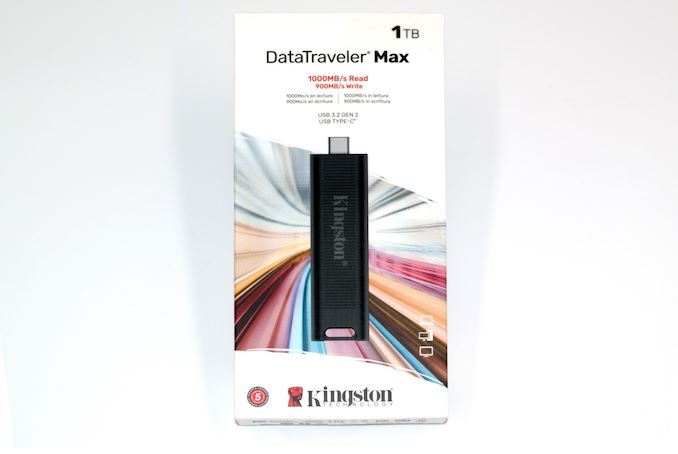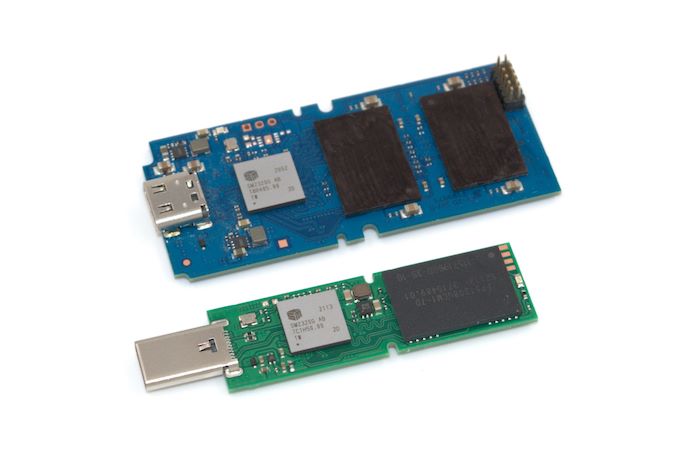Kingston DataTraveler Max UFD Review: NVMe Performance in a USB Thumb Drive
by Ganesh T S on September 30, 2021 10:00 AM EST
Rapid advancements in flash technology and continued improvements in high-speed interfaces have driven the growth of small, bus-powered portable SSDs. Over the last few years, these types of drives have relied on a dual-chip solution - typically placing a SATA or NVMe SSD behind a USB bridge chip. SSD controller vendors such as Phison and Silicon Motion have recognized the growth potential in the portable SSD market and come out with USB Flash Drive (UFD) controllers employing high-speed direct-attach interfaces on the upstream side, and directly talking to the flash packages downstream. These controllers have now created a new category of portable SSDs by lowering the cost without sacrificing performance.
Kingston's DataTraveler Max was introduced in August 2021 as a USB-C flash drive capable of hitting 1GBps speeds. The claimed performance numbers justify calling the thumb drive as a portable SSD. While Kingston did not publicly disclose the internals of the drive, the form-factor and performance numbers point to the use of a native UFD controller. Kingston is not the first to the market with such a high-performance portable SSD. Crucial's X6 (updated in 2021 with Phison's U17 UFD controller) reaches speeds of 800MBps+, but it retains the industrial design of the older version (which was a SATA drive behind a USB - SATA bridge).
To that end, today we're digging into the 1TB version of the DataTraveler Max (referred to here on as DT Max), which Kingston has provided. We'll be taking a look at the performance, power efficiency, and value proposition of the DT Max. We've also cracked the drive open in order to confirm which UFD controller Kingston is using.
Introduction and Product Impressions
External bus-powered storage devices have grown both in storage capacity as well as speeds over the last decade. Thanks to rapid advancements in flash technology (including the advent of 3D NAND and NVMe) as well as faster host interfaces (such as Thunderbolt 3 and USB 3.2 Gen 2x2), we now have palm-sized flash-based storage devices capable of delivering 2GBps+ speeds.
The thumb drive form factor is attractive for multiple reasons - there is no separate cable to carry around, and the casing can be designed to include a keyring loop for portability. Vendors such as Corsair and Mushkin briefly experimented with SATA SSDs behind a USB bridge chip, but the thermal solution and size made the UFDs slightly unwieldy. While the weight was fine for a Type-A male connector, putting such drives behind a Type-C connector would have required extensive redesign. The introduction of high-performance native UFD controllers has made this category viable again.
Kingston's DT Max retains the traditional DataTraveler thumb drive form-factor. However, it takes full advantage of the USB 3.2 Gen 2 Type-C male connector by promising 1GBps speeds. Available in three capacities - 256GB, 512GB, and 1TB, Kingston says that they can deliver those high speeds across all three SKUs.
The industrial design is slightly different from other DataTraveler UFDs. The Type-C male connector is protected by a sliding cap. Retracting and covering it again can be done with a single hand. There is also a blue LED indicator and a keyring loop at the end. The thumb drive measures 82.6 mm x 22.3 mm x 9.5 mm and tips the scales at around 12.5 grams.
Tearing down the UFD is a simple matter of popping off the sliding cap and prying out the internal cover. There are no screws in the drive. The bare board inside has no special thermal solution. We see Silicon Motion's SM2320 UFD controller here, but the package seems to be different from the one we saw in the SM2320 USB 3.2 Gen 2x2 reference design reviewed earlier this month.

Kingston XS2000 (SM2320 Reference Design) [top] vs. Kingston DT Max (SM2321?) [bottom]
For comparison purposes, we have only limited 1TB results with our new test suite and testbed. Hence, we only present metrics from two USB 3.2 Gen 2 NVMe bridges from Akasa - one using ASMedia's ASM2362, and another using Realtek's RTL9210B.
CrystalDiskInfo provides a quick overview of the capabilities of the internal storage device. Since the program handles each bridge chip / controller differently, and the SM2320 is quite new, many of the entries are marked as vendor-specific, and some of the capabilities (such as the interface) are deciphered incorrectly. The temperature monitoring worked well, though.
| S.M.A.R.T Passthrough - CrystalDiskInfo | |
 |
 |
The table below presents a comparative view of the specifications of the different storage bridges presented in this review.
| Comparative Direct-Attached Storage Devices Configuration | ||
| Aspect | ||
| Downstream Port | Native Flash | 1x PCIe 3.0 x2 (M.2 NVMe) |
| Upstream Port | USB 3.2 Gen 2 Type-C (Male) | USB 3.2 Gen 2 Type-C |
| Bridge Chip | Silicon Motion SM2320 | ASMedia ASM2362 |
| Power | Bus Powered | Bus Powered |
| Use Case | 1GBps-class, compact USB thumb drive with retractable cover for Type-C connector | M.2 2230 / 2242 / 2260 / 2280 NVMe SSD aluminum enclosure DIY 1GBps-class portable SSD with a USB flash drive-like form-factor |
| Physical Dimensions | 82.6 mm x 22.3 mm x 9.5 mm | 125 mm x 32 mm x 10.8 mm |
| Weight | 12.5 grams | 52 grams (without SSD) |
| Cable | N/A | 30 cm USB 3.2 Gen 2 Type-C to Type-C |
| S.M.A.R.T Passthrough | Yes | Yes |
| UASP Support | Yes | Yes |
| TRIM Passthrough | Yes | Yes |
| Hardware Encryption | Not Available | SSD-dependent |
| Evaluated Storage | Micron 96L 3D TLC | SK hynix P31 PCIe 3.0 x4 NVMe SSD SK hynix 128L 3D TLC |
| Price | USD 180 | GBP 60 (Scan) |
| Review Link | Kingston DT Max 1TB Review | Akasa AK-ENU3M2-03 Review |
Prior to looking at the benchmark numbers, power consumption, and thermal solution effectiveness, a description of the testbed setup and evaluation methodology is provided.
Testbed Setup and Evaluation Methodology
Direct-attached storage devices (including thumb drives) are evaluated using the Quartz Canyon NUC (essentially, the Xeon / ECC version of the Ghost Canyon NUC) configured with 2x 16GB DDR4-2667 ECC SODIMMs and a PCIe 3.0 x4 NVMe SSD - the IM2P33E8 1TB from ADATA.
The most attractive aspect of the Quartz Canyon NUC is the presence of two PCIe slots (electrically, x16 and x4) for add-in cards. In the absence of a discrete GPU - for which there is no need in a DAS testbed - both slots are available. In fact, we also added a spare SanDisk Extreme PRO M.2 NVMe SSD to the CPU direct-attached M.2 22110 slot in the baseboard in order to avoid DMI bottlenecks when evaluating Thunderbolt 3 devices. This still allows for two add-in cards operating at x8 (x16 electrical) and x4 (x4 electrical). Since the Quartz Canyon NUC doesn't have a native USB 3.2 Gen 2x2 port, Silverstone's SST-ECU06 add-in card was installed in the x4 slot. All non-Thunderbolt devices are tested using the Type-C port enabled by the SST-ECU06.
The specifications of the testbed are summarized in the table below:
| The 2021 AnandTech DAS Testbed Configuration | |
| System | Intel Quartz Canyon NUC9vXQNX |
| CPU | Intel Xeon E-2286M |
| Memory | ADATA Industrial AD4B3200716G22 32 GB (2x 16GB) DDR4-3200 ECC @ 22-22-22-52 |
| OS Drive | ADATA Industrial IM2P33E8 NVMe 1TB |
| Secondary Drive | SanDisk Extreme PRO M.2 NVMe 3D SSD 1TB |
| Add-on Card | SilverStone Tek SST-ECU06 USB 3.2 Gen 2x2 Type-C Host |
| OS | Windows 10 Enterprise x64 (21H1) |
| Thanks to ADATA, Intel, and SilverStone Tek for the build components | |
The testbed hardware is only one segment of the evaluation. Over the last few years, the typical direct-attached storage workloads for memory cards have also evolved. High bit-rate 4K videos at 60fps have become quite common, and 8K videos are starting to make an appearance. Game install sizes have also grown steadily even in portable game consoles, thanks to high resolution textures and artwork. Keeping these in mind, our evaluation scheme for portable SSDs and UFDs involves multiple workloads which are described in detail in the corresponding sections.
- Synthetic workloads using CrystalDiskMark and ATTO
- Real-world access traces using PCMark 10's storage benchmark
- Custom robocopy workloads reflective of typical DAS usage
- Sequential write stress test
In the next section, we have an overview of the performance of the Kingston DT Max in these benchmarks. Prior to providing concluding remarks, we have some observations on the UFD's power consumption numbers and thermal solution also.

















12 Comments
View All Comments
yetanotherhuman - Monday, October 4, 2021 - link
Install ublock origin.You're welcome.
watersb - Wednesday, October 6, 2021 - link
Usually I don't support comments like this... but...The auto playing video ad floats above the content, rendering the site unusable on my primary browsing device, a 2020 iPhone SE.
I don't know if there is a simple config to fix this, but it's worth a review. Can't read the site.
Excited about next gen simple USB UFS drives, though !